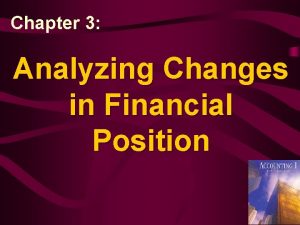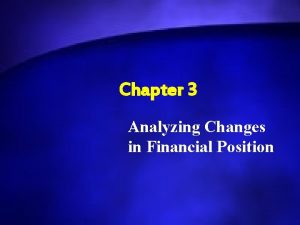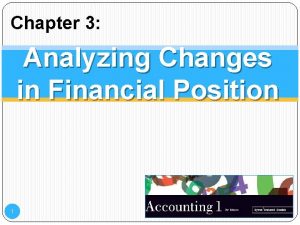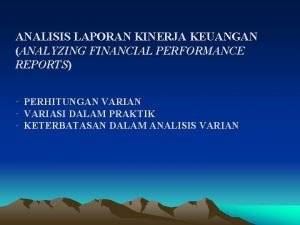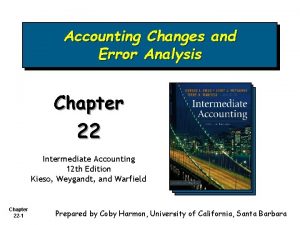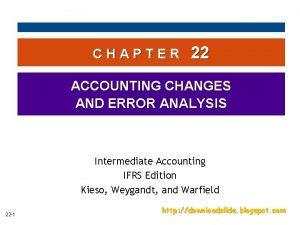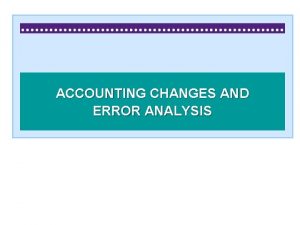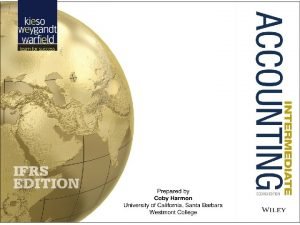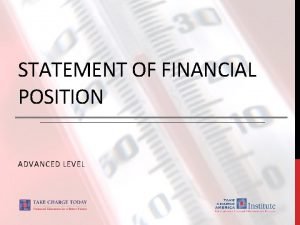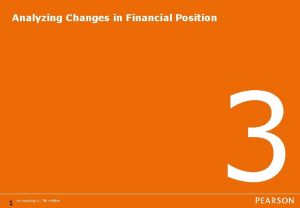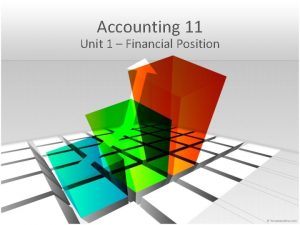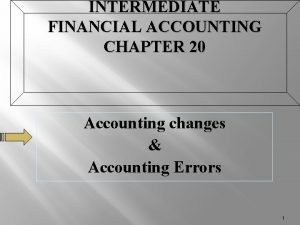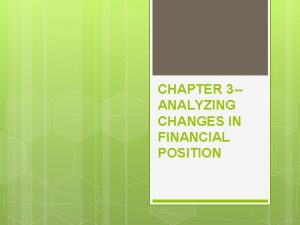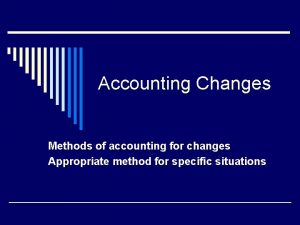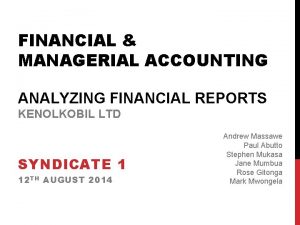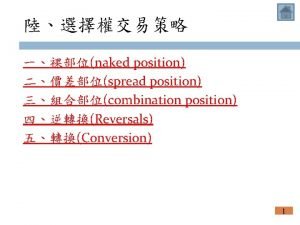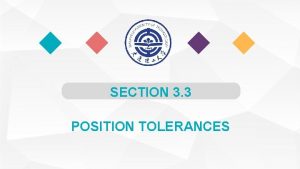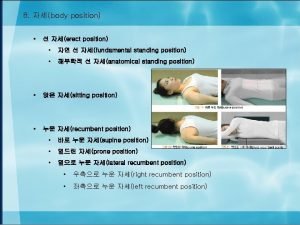Analyzing Changes in Financial Position 1 Accounting 1




















- Slides: 20

Analyzing Changes in Financial Position 1 Accounting 1, 7 th edition 3

Agenda Chapter 3 Learning goals Vocabulary 3. 1 Business Transactions 3. 2 Equation Analysis Sheet 2 Accounting 1, 7 th edition

Learning Goals 1. 2. 3. 4. 5. 6. 3 Understand what a business transaction is and be able to recognize one Understand what a source document is and be able: give examples and collect information from it to make a transaction Understand the objectivity principle and how it related to source documents Understand what is an equation analysis sheet and be able to use one to record business transaction Understand what accounts business transactions affect Make a new balance sheet using equation analysis sheet Accounting 1, 7 th edition

Vocabulary Business transaction Equation analysis sheet Objectivity principle Source document 4 Accounting 1, 7 th edition

3. 1 Business Transactions Business transaction: financial event that causes a change in financial position • Ex: a business buys a truck for which it pays $20 000 cash. This event is a transaction because it causes the financial position of the business to change. • Assets: Truck increase by $20 000 and Cash decrease by $20 000. • A city plumbing inspector inspects the building and leaves a letter suggesting some improvements. Is this a business transaction? • 5 Accounting 1, 7 th edition

Source Documents Whenever a business records an assets, liability or equity item a business paper or document is required to verify the dollar amount. This is called Source document • It is the original record of the transaction and it provided accounting personnel with the information they need to process the transaction properly • 6 Accounting 1, 7 th edition

Source Documents • 7 Examples: • Hydro bill • Telephone bill • Cheque copies • Store receipts • Cash register • Credit card slip Accounting 1, 7 th edition

Source Documents What you must remember: 1. Accounting entries are made from business papers known as source documents 2. Source documents are kept on file for reference purposes and are proof of transaction 8 Accounting 1, 7 th edition

Accounting Standards- The Objectivity Principle Objectivity principle: requires that a business’s accounting be recorded on the basis of CLEAR; VARIFIABLE EVIDENCE. • Meaning that different people looking at the same evidence will arrive at the same values for the transaction. • Record FACTS no personal opinion or feelings • 9 Accounting 1, 7 th edition

Apply your knowledge Page 59 Review Questions 1 -7 and exercises 1 -5 10 Accounting 1, 7 th edition

Equation Analysis Sheet • Now we will begin to look at how business transaction affect and change the financial position Business transaction 11 Accounting 1, 7 th edition Change in Financial Position

Figure 3. 1 Chapter 3 Figure 3. 1: Metropolitan Movers Balance Sheet 12 Accounting 1, 7 th edition

Equation Analysis Sheet What business transaction occur, where do you record them? • Balance sheet? • NO! the balance sheet is not a suitable type of record on which to record these changes. • Therefore, we transfer assets, liabilities and capital from the balance sheet into what we will call an equation analysis sheet • Equation analysis sheet: is a tool for displaying individual transactions and the new financial position resulting from each transaction 13 Accounting 1, 7 th edition

Figure 3. 2 14 Accounting 1, 7 th edition Chapter 3

Power. Point 3– 2 (part 1) Chapter 3 Transactions for Metropolitan Movers Transaction 1 Metropolitan Movers pays $1200 cash to reduce the Bank Loan. Transaction 2 K. Lincoln, who owes Metropolitan Movers $2500, pays $1100 in partial payment of the debt. Transaction 3 Equipment costing $1950 is purchased for cash. Transaction 4 A pick-up truck is purchased at a cost of $18 000. Metropolitan Movers pays $10 000 cash and arranges a loan from its bank to cover the balance of the purchase price. 15 Accounting 1, 7 th edition

Power. Point 3– 2 (part 2) Chapter 3 Transactions for Metropolitan Movers Transaction 5 Metropolitan Movers completes a storage service for B. Cava at a price of $1500. A bill is sent to Cava to indicate the additional amount that is owed. Transaction 6 J. Hofner, the owner, withdraws $500 for personal use. Transaction 7 One of the trucks requires an engine adjustment costing $375. The repair is paid for in cash when the truck is picked up. 16 Accounting 1, 7 th edition

Power. Point 3– 3 Chapter 3 Figure 3. 9: Completed Equation Analysis Sheet for Metropolitan Movers 17 Accounting 1, 7 th edition

Figure 3. 10 Updating the Balance Sheet 18 Accounting 1, 7 th edition

Summary of Steps in analyzing a Transaction Step 1: identify all assets and liability items that must be changed and make all necessary changes. Step 2: See if the owner’s equity has changed ( if assets changed and liabilities did not change than owner’s equity must change) Step 3: Make certain that at least two of the individual items have changed Steps 4: make sure that the equation is still in balance (A = L + OE) 19 Accounting 1, 7 th edition

Practice Page 69: Review questions 1 -10 and exercises 1 -3 20 Accounting 1, 7 th edition
 Chapter 3 analyzing changes in financial position answers
Chapter 3 analyzing changes in financial position answers Chapter 3 analyzing changes in financial position answers
Chapter 3 analyzing changes in financial position answers Chapter 3 analyzing changes in financial position answers
Chapter 3 analyzing changes in financial position answers First position second position third position
First position second position third position Another name for statement of financial position
Another name for statement of financial position Intermediate accounting chapter 1
Intermediate accounting chapter 1 Accounting responsibility
Accounting responsibility Changes in latitudes, changes in attitudes meaning
Changes in latitudes, changes in attitudes meaning Physical change
Physical change Analyzing financial performance reports
Analyzing financial performance reports Chapter 2 analyzing transactions
Chapter 2 analyzing transactions Chapter 22 accounting changes and error analysis
Chapter 22 accounting changes and error analysis Chapter 22 accounting changes and error analysis
Chapter 22 accounting changes and error analysis Accounting changes and error corrections
Accounting changes and error corrections Utility of price level accounting
Utility of price level accounting Accounting changes and error analysis
Accounting changes and error analysis Fundamental position vs anatomical position
Fundamental position vs anatomical position Definition of fundamental position
Definition of fundamental position Tori's statement of financial position answer key
Tori's statement of financial position answer key Report form statement of financial position
Report form statement of financial position Statement of financial position
Statement of financial position
